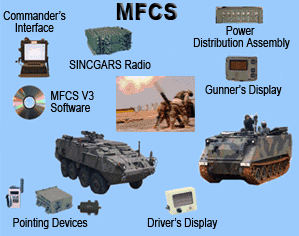Mortar carrier
Mortar carriers are military vehicles that either transport a mortar to be fired from the ground, or directly from the carrier vehicles. They are most common for the 120mm mortar, which is the most common heavy indirect fire support weapon organic to infantry units. Especially in Russian-influenced forces, there may be mortar carriers for larger mortars (e.g., 240mm) operated by artillery units.
Smaller than 120mm
Mortar carriers armed with smaller than 120mm mortars are rare. The U.S. M1025 was deployed with 81mm mortars, but has primarily been converted to the 120mm M1064. M1129 carriers are equipped with an additional 60mm or 81mm mortar, which the crew remove from the vehicle and mount on the ground before it can be fired.
120mm
Among the most common is a mortar carrier based on the ubiquitous U.S. M113 armored personnel carrier, M1064 mortar carrier. Also, in the U.S. Army, the M1129 mortar carriers is the Stryker (armored fighting vehicle) version. The XM1204 NLOS mortar was cancelled, in 2009, along with other manned ground vehicles of the Future Combat Systems.
China builds the YW-381 mortar carrier on an YW-531 armored personnel carrier. Its mortar is fixed to the vehicle floor such that it cannot traverse (i.e., move in azimuth); to adjust fire, the vehicle has to move. Patria, of Finland, builds and exports mortar carriers as part of its AMV fighting vehicle family, and Thales Australia has a mortar carrier variant within its Bushmaster series.
There are a variety of Russian (former Soviet) designs for 120mm mortar carriers. [1], including the 2S9 (SO-120) Anona (based on the BTR-D armored personnel carrier), the 2S23 NONA-SVK based on a BTR-80, the latest 2S31 Vena using a BMP-3, and the old MT-LB based carrier. Russian designers tend to put the mortar into a turret, while western designs more often have it in the open back of a vehicle.
Fire control
The U.S. Army Mortar Fire Control System (MFCS) supports both the M1129 and M1064 vehicles.
It has a local GPS receiver, but also connects to the Advanced Field Artillery Tactical Data System. With unguided shells, it gives 3 mil azimuth and 1 mil elevation pointing accuracy.[2] Israel's Keshet Weapons System is not a full carrier, but rather a replacement for the M121 mortar in any M1064 mortar carrier. It gives the unit commander remote control over mortar fire. An article states delivery is being made to the U.S. Army as well as Israel.[3]
Heavier mortars
Russia and the Soviet Union have deployed the 240mm SM-240 (2S4) Tyul’pan mortar carrier since 1975; it was also used by Iraq and Lebanon The weapon is breech-loaded from a magazine and is capable of full-automatic fire. While it is unlikely that nuclear ammunition exists for it, it was capable of firing a tactical nuclear weapon.
References
- ↑ Russian mortar carriers
- ↑ MFCS, U.S. Army
- ↑ "Israel deploys new mortar", DefenseTech
